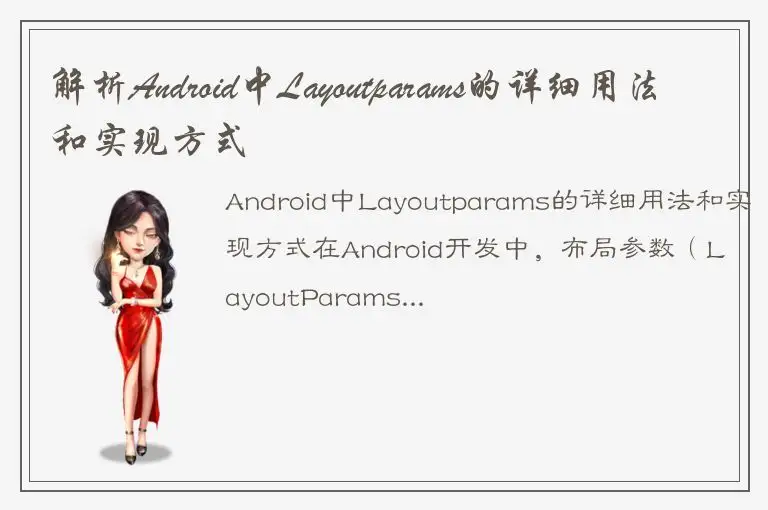Android中Layoutparams的详细用法和实现方式

在Android开发中,布局参数(LayoutParams)是一组用于描述视图相对于其父容器的布局规则的对象。它们用于规定一个视图在屏幕上是如何布局的,以及这个视图应该如何与其他视图进行交互。
在本文中,我们将探讨LayoutParams的用法、实现方式以及如何将其应用到不同类型的布局中。
1. LayoutParams类
LayoutParams是一个抽象类,它是容器类的抽象父类,它定义了所有LayoutParams子类的通用属性和方法。LayoutParams子类的目的是定义特定布局容器的布局规则,比如LinearLayout.LayoutParams和RelativeLayout.LayoutParams。
LayoutParams包括以下基本属性:
- width和height:确定视图的宽度和高度。
- gravity:确定视图的对齐方式。常用值为CENTER、LEFT、RIGHT等。
- layout_weight:如果父容器是LinearLayout,则表示视图的比重(权重)。
- margin:指定视图的外边距。
LayoutParams的实现方式是,直接在XML文件中指定它们的属性值,如下所示:
```
android:layout_width="match_parent" android:layout_height="match_parent" android:orientation="horizontal"> android:layout_width="100dp" android:layout_height="wrap_content" android:text="Hello" android:layout_weight="1"/> android:layout_width="100dp" android:layout_height="wrap_content android:text="World" android:layout_weight="1"/> ``` 2. LinearLayout.LayoutParams LinearLayout是Android开发中最常用的容器之一,它可以横向或纵向排列子视图。因此,LinearLayout.LayoutParams类被广泛应用于开发过程中。 要使用LinearLayout.LayoutParams,需要创建一个新的LinearLayout.LayoutParams对象,并将其添加到LinearLayout的子视图中。使用setMargins()方法设置视图的外边距。 下面是一个示例,展示了如何在LinearLayout容器中使用LayoutParams: ``` android:layout_width="match_parent" android:layout_height="match_parent" android:orientation="vertical"> android:layout_width="match_parent" android:layout_height="wrap_content" android:text="Hello World"/> android:layout_width="match_parent" android:layout_height="wrap_content" android:orientation="horizontal"> android:layout_width="wrap_content" android:layout_height="wrap_content" android:text="Left" android:layout_weight="1" android:gravity="left" android:layout_marginRight="10dp"/> android:layout_width="wrap_content" android:layout_height="wrap_content" android:text="Right" android:layout_weight="1" android:gravity="right" android:layout_marginLeft="10dp"/> ``` 在这个例子中,我们使用LinearLayout来垂直排列子视图,然后使用另一个LinearLayout容器在水平方向上排列两个文本视图。左边的文本视图使用android:gravity="left"属性左对齐,右边的文本视图使用android:gravity="right"属性右对齐,并使用android:layout_weight="1"属性设置宽度为父布局的一半。 3. RelativeLayout.LayoutParams RelativeLayout是Android中另一个常用的容器,它是一个灵活的容器,允许你在相对布局中放置子视图。RelativeLayout.LayoutParams类定义了RelativeLayout的布局规则。 在RelativeLayout中,视图的布局位置通常由其与其他视图的位置关系决定。在设置LayoutParams的每个属性之前,请考虑相应视图的相对位置。 下面是一个展示RelativeLayout.LayoutParams的示例: ``` android:layout_width="match_parent" android:layout_height="match_parent"> android:id="@+id/button1" android:layout_width="100dp" android:layout_height="wrap_content" android:text="Button 1"/> android:id="@+id/button2" android:layout_width="100dp" android:layout_height="wrap_content" android:text="Button 2" android:layout_below="@id/button1" android:layout_alignParentEnd="true" android:layout_marginTop="20dp" android:layout_marginEnd="20dp"/> ``` 在这个例子中,我们创建了两个按钮,一个在另一个按钮的下方,并且右对齐。我们使用android:layout_below="@id/button1"属性确保第二个按钮在第一个按钮的下方,然后使用android:layout_alignParentEnd="true"属性将第二个按钮与其父容器的右端对齐,并使用android:layout_marginTop="20dp"属性和android:layout_marginEnd="20dp"属性将其与其父容器上方和右边各20dp。(注:本例子是Android 7.0及以上版本;通常情况下,该属性可替换为android:layout_alignParentRight="true") 4. TableLayout.LayoutParams TableLayout是另一个常用的容器,它用于创建水平和垂直方向上等间距排列的行列式视图。TableLayout.LayoutParams定义了TableLayout的布局规则。 在TableLayout中,视图通常通过行和列索引来定位。可以使用android:layout_column和android:layout_row属性设置表格中的视图所在行和列。 下面是一个展示TableLayout.LayoutParams的示例: ``` android:layout_width="match_parent" android:layout_height="match_parent"> android:text="Name" android:textStyle="bold" android:layout_weight="1"/> android:text="Age" android:textStyle="bold" android:layout_weight="1"/> android:text="John Doe" android:layout_weight="1"/> android:text="25" android:layout_weight="1"/> ``` 在这个例子中,我们定义了两个行,每个行有两个TextView视图。我们设置了TextView的android:layout_weight="1"属性,以便让他们等分总宽度。表格的其余部分将由系统自动计算。 总结 LayoutParams是一个用于描述视图相对于其父容器的布局规则的对象。它们是应用程序中设计界面的基础。LinearLayout.LayoutParams、RelativeLayout.LayoutParams和TableLayout.LayoutParams是三个应用最广泛的子类,分别用于线性、相对和表格布局。 学习如何灵活地使用布局参数Layoutparams,将有助于我们在开发中更好地控制视图的布局和交互。




 QQ客服专员
QQ客服专员 电话客服专员
电话客服专员